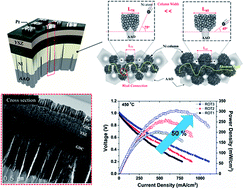Low-temperature, high-performance thin-film solid oxide fuel cells with tailored nano-column structures of a sputtered Ni anode†
Abstract
A nanostructured electrode for use in low-temperature solid oxide fuel cells has drawn attention due to its high activity. Among various nanostructure fabrication processes, sputtering has shown superior characteristics for nanostructured electrode fabrication and does not require high temperatures. However, the limited performance of sputtered Ni-based anodes and the current lack of a fundamental understanding of nanostructural control remain significant issues. Here, the fabrication process for a high-performance nanostructured Ni anode that works by tailoring a nano-column structure is presented. Controlling the sputtering deposition angle and rotation speed of the substrate significantly improves the in-plane connectivity of the nanostructured Ni anode, resulting in a 50% enhancement in the peak power density of the cell. The maximum performance of the cell with the tailored anode nanostructure was 304 and 477 mW cm−2 at 450 and 500 °C, respectively, which represents the best recorded performance of an anodic aluminum oxide (AAO)-supported Ni-based thin-film SOFC. Further investigation via 1-dimensional simulation showed that the enhancement in the in-plane continuity of the columnar anode structure dominantly affects the performance of TF-SOFCs, which means that the novel process is promising for practical applications of nano-energy devices fabricated by sputtering.



 Please wait while we load your content...
Please wait while we load your content...